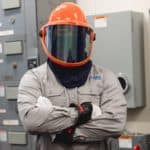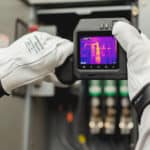Faults in electrical equipment can be challenging to spot. An electrical asset can still operate with a poor connection or failing component. Facilities that rely on this equipment must assess it regularly to maintain its function and safety.
Infrared equipment can be a powerful resource when assessing electrical assets. Detecting deviations from normal operating conditions helps your facility prevent severe accidents and unplanned downtime.
Fortunately, infrared inspections can provide numerous benefits to your organization’s safety, reliability, and maintenance goals, including:
- Early fault detection
- Increased equipment lifespan
- Cost savings
- Identification of hazardous conditions
- Non-invasive and non-contact method
- Compliance with safety standards
Read on for what, why, and how of top-notch electrical infrared inspection services.
How Does Infrared Thermography Work?
Functioning electrical components generate heat at the component level. Under similar loads, similar parts should produce about the same heat. Variations from normal temperatures may indicate a problem.
Infrared thermography inspections involve a technician scanning an asset with infrared equipment. The resulting image uses colors to indicate different heat levels. These scans can help diagnose problems and catch minor-to-critical issues before they result in dangerous conditions.
Benefits of Using Infrared Equipment for Inspections
The primary benefits of predictive maintenance tools like infrared thermography are facility safety and operational reliability. However, regular inspections can bring several other benefits. They include:
Workplace Safety
Malfunctioning electrical equipment can be a serious safety hazard. Poor connections or other issues may cause damaging electrical fires and arc flashes. A regular infrared program can identify these issues early and prevent injuries and fatalities.
Consistent Operation
A faulty component will often operate at a higher temperature before it fails. System failure may be the first sign of a problem without regular inspection. Unexpected shutdowns will disrupt operations further down the line. Infrared inspection catches the issue and allows repairs at a convenient time.
Identify Failed Components
Infrared scans can identify flawed or failed components in an electrical asset. When components within a system malfunction or degrade, they often exhibit temperature variations that the infrared camera can detect. This process allows your technicians or engineers to pinpoint potential issues before they escalate into significant failures or costly breakdowns.
Energy Efficiency
Increased infrared radiation coincides with wasted electricity. Regular maintenance guided by infrared thermography will maintain or improve the efficiency of your electrical systems, resulting in energy savings and carbon emission reduction.
Employing infrared Thermography as a Predictive Maintenance Tool
For over 50 years, infrared thermography has proven to be a reliable and cost-effective tool for electrical system maintenance programs. These programs can produce increased workplace safety and reliability and reduce the risk of failure.
Developing an Infrared Program at Your Facility
Effective predictive maintenance requires a well-designed and intentional program. Your facility must develop protocols that involve regular inspections with appropriate assessment tools. Current National Fire Protection Agency (NFPA) 70B guidelines require an infrared inspection of electrical assets every 12 months.
Creating a Baseline
Taking a baseline measurement is the first step when using any predictive maintenance tool. Safety technicians should observe new devices to gauge their operation under normal conditions. Your facility should have a baseline image for infrared thermography for every equipment on file.
Maintaining a Digital History
When inspectors take an infrared picture, the best practice is to save it in a digital file. This practice allows your facility to build a history of a device’s operation. They can observe operational changes over time, allowing them to develop a service, repair, and replacement schedule.
Ultimate Data Control with ViewPoint®
Proper data capture is key when utilizing predictive maintenance tools like infrared thermography. SEAM Group offers ViewPoint®, a simple, scalable technology platform customers use across multiple industries, including distribution, logistics, hospitality, manufacturing, electric vehicle charging, data centers, food service, building management, and more.
Since being implemented as a solution for SEAM Group customers, ViewPoint has been used by thousands of registered users, generating more than $1 billion in downtime cost savings by quickly identifying and correcting issues.
Customers use ViewPoint as a multi-disciplined solution combining and analyzing data gathered from infrared, vibration, oil, ultrasound, and motor current testing, as well as safety services like arc flash hazards analysis and digital lockout/tagout programs. ViewPoint supports data management for one or hundreds of facilities and enables multiple users’ personalized access levels – helping you genuinely level up your infrared thermography effectiveness.
Specializing in Predictive Maintenance Tools
Effective electrical asset management can feel like an overwhelming task. If you are concerned about inspection protocols pulling your employees away from their regular tasks, consider working with a partner who specializes in predictive maintenance. Inspection services from SEAM Group help companies identify safety risks and safeguard their electrical assets. Our team works with infrared thermography and other predictive maintenance tools to create a safe, more reliable workplace.





